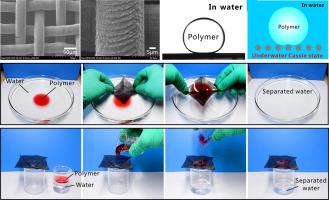Journal of Colloid and Interface Science ( IF 9.4 ) Pub Date : 2020-09-08 , DOI: 10.1016/j.jcis.2020.09.010 Jiale Yong 1 , Xue Bai 1 , Qing Yang 2 , Xun Hou 3 , Feng Chen 1

|
The widespread use of liquid polymers may pollute water, causing grave environmental problems and even various human diseases. The separation of a mixture of a liquid polymer and water is extremely important in research, but the high viscosity, low fluidity, and high adhesion performance of liquid polymers make this task highly challenging. In this paper, we propose a novel strategy for separating a polymer/water mixture wherein porous underwater superpolymphobic micro/nanostructures are used for the first time. Femtosecond laser (fsL) processing is used to form micro/nanoscale surface structures on a stainless steel mesh (SSM), resulting in excellent repellence (underwater superpolymphobicity) to various liquid polymer droplets in water. The laser-induced underwater superpolymphobicity is very stable even though the SSM suffers from different damage treatments (e.g., sandpaper abrasion, acid or alkali solutions corrosion, UV light irradiation, and tape peeling). The underwater superpolymphobicity is ascribed to an underwater Cassie contact state between the underwater liquid polymer and the surface microstructure of the laser-treated SSM. We demonstrate that the underwater superpolymphobic SSM can be effectively and repeatedly used to separate liquid polymer/water mixtures with a high separation efficiency of 99.0% and a high separation flux of 4.45 × 105 L m−2h−1. The mixtures of water and different polymers are successfully separated. Such a separation strategy can potentially alleviate pollution from liquid polymer discharge, recycle waste polymer resources, and be applied in polymer production and manufacturing.
中文翻译:

通过使用飞秒激光生产的水下超疏水网,过滤并从水中除去液态聚合物(聚合物/水分离)。
液态聚合物的广泛使用可能污染水,从而导致严重的环境问题,甚至引起各种人类疾病。液体聚合物和水的混合物的分离在研究中非常重要,但是液体聚合物的高粘度,低流动性和高粘附性使这项任务极具挑战性。在本文中,我们提出了一种分离聚合物/水混合物的新策略,其中首次使用了多孔的水下超疏水微结构/纳米结构。飞秒激光(fsL)处理用于在不锈钢网(SSM)上形成微米/纳米级的表面结构,从而对水中的各种液态聚合物小滴具有极佳的排斥力(水下超多疏水性)。即使SSM受到不同的损伤处理(例如,砂纸磨损,酸或碱溶液腐蚀,UV射线照射和胶带剥离),激光诱导的水下超疏水性也非常稳定。水下超疏水性归因于水下液体聚合物与激光处理过的SSM的表面微观结构之间的水下Cassie接触状态。我们证明了水下超多疏水性SSM可以有效且重复地用于分离液态聚合物/水混合物,分离效率高达99.0%,分离通量高达4.45×10 水下超多疏水性归因于水下液体聚合物与经激光处理的SSM的表面微观结构之间的水下Cassie接触状态。我们证明了水下超多疏水性SSM可以有效且重复地用于分离液体聚合物/水混合物,分离效率高达99.0%,分离通量高达4.45×10 水下超多疏水性归因于水下液体聚合物与经激光处理的SSM的表面微观结构之间的水下Cassie接触状态。我们证明了水下超多疏水性SSM可以有效且重复地用于分离液体聚合物/水混合物,分离效率高达99.0%,分离通量高达4.45×105 L m -2 h -1。水和不同聚合物的混合物已成功分离。这种分离策略可以潜在地减轻液体聚合物排放带来的污染,回收废弃聚合物资源,并应用于聚合物生产和制造中。











































 京公网安备 11010802027423号
京公网安备 11010802027423号